In this post I’ll tell you all about Shaoxing wine, why and how you should get some, how to use it, and more!
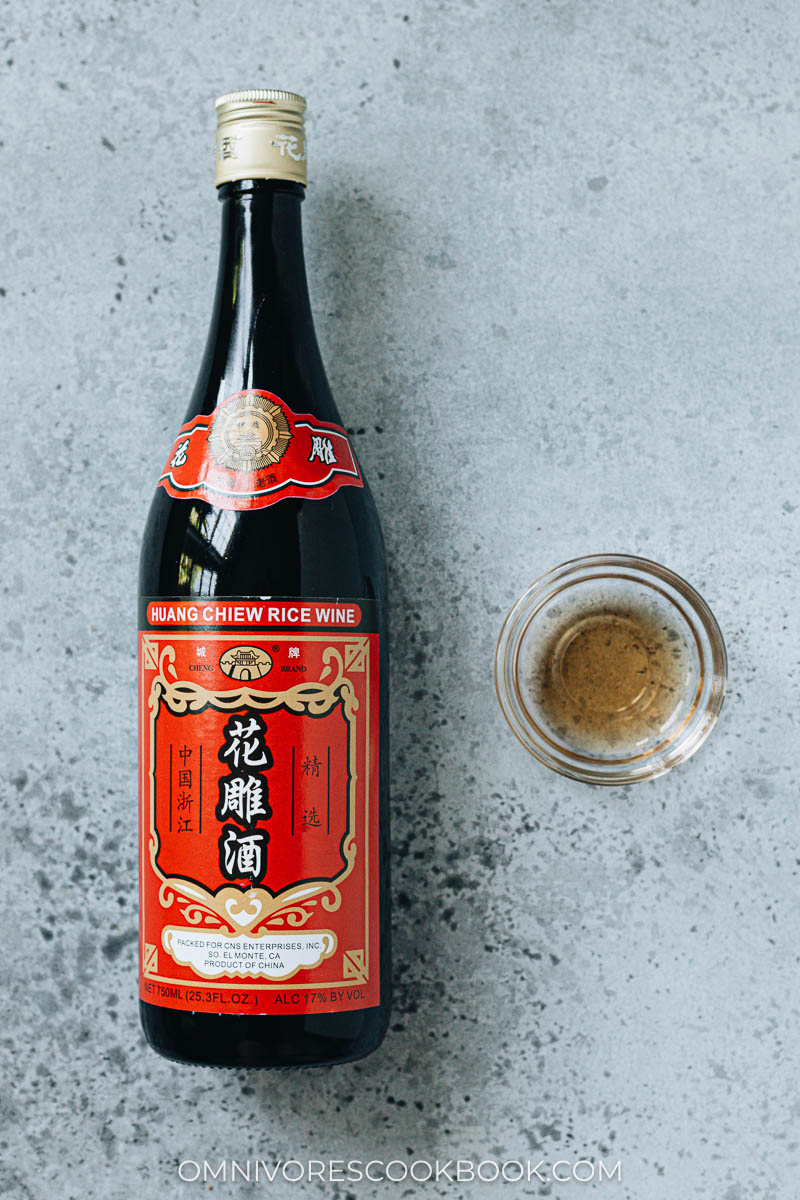
Table of contents
What is Shaoxing wine?
Shaoxing wine (绍兴酒, shàoxīng jiǔ) is a Chinese rice wine produced in the city of Shaoxing, in eastern China. It is a variety of “yellow wine” (黄酒, huángjiǔ) and it has a transparent dark amber color. The wine is usually between 15 and 18% alcohol by volume.
It is used extensively in all kinds of Chinese cooking. Its fragrance and umami flavor are unmistakable and essential in creating authentic renditions of many Chinese dishes.
A note on naming and labeling
Shaoxing wine may be labeled “Shao Xing”, “Shao Hsing”, or “Shaohsing”. And any type of “huang jiu” (黄酒) or “huang chiew” should generally also be usable as Shaoxing wine.
The label may say “Shaoxing rice wine” or “Shaoxing Hua Tiao rice wine” or “Shaoxing Hua Diao rice wine” or some combination of all these terms. They all refer to what we’re talking about here.
Additionally, the label may contain the word “cooking”, as in “Shaoxing cooking wine”. This means that the bottle contains added salt. Read more on this in the “How to shop” section below.
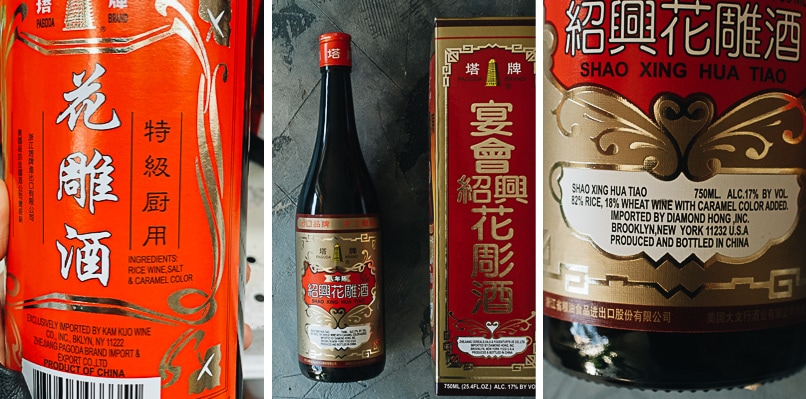
How it’s made
Shaoxing wine is made much like other rice wines, though the particular use of glutinous rice, some wheat, and a special red fermented rice (红曲米, hóng qū mí) provide its distinctive aroma and color. Shaoxing wine is typically made in the region surrounding the city of Shaoxing and traditionally uses spring water from the nearby mineral-rich Jian Lake.
Here’s a brief overview of the process:
- Glutinous rice is fully steamed to release the starch and create sugar
- It’s cooled a bit, then mixed with red fermented rice, which contains yeast, while still slightly warm
- That mixture is allowed to ferment initially for 3-5 days
- Fermented wheat and Jian Lake spring water are added
- It will be allowed to ferment for around 90 days to achieve the desired alcohol content
- The wine is then transferred into clay urns, where it is stored and allowed to age for anywhere from 3 months to 10+ years
Shaoxing wine, like many Western wines, depends on the climate, soil, water, and ambient microorganisms particular to the area where it’s made. These numerous local factors all contribute to Shaoxing wine’s unique character.
To see what a Shaoxing winery looks like, check out this video.
A tablespoon of history
Shaoxing wine dates back over 2000 years, to the Spring and Autumn Period (770-476 BC) of Chinese history. By that time, the Shaoxing area was already renowned for its climate, water quality, and glutinous rice production.
Making wine was a special way to preserve some of the year’s rice surplus. Surpluses didn’t happen every year, and famines were not uncommon. Shaoxing wine would not only last many years, but it even got better with age, so it was ideal for these unpredictable times.
By the Han Dynasty (206 BC to 220 AD) Shaoxing wine had become known throughout China. It became a favorite drink of poets and artists, and cooking methods incorporated it thoroughly, making it a prized and essential ingredient in the millennia since.
What does it taste like
Shaoxing wine has a flavor profile that is balanced between nutty, earthy, fruity, and savory.
The sommelier part of me has this to say:
- It has a very savory, kind of musty and leathery aroma. You can smell both the glutinous rice (sweet) and the fermented wheat (slightly funky).
- The flavor is initially malty (thanks again, to the rice and the wheat), with notes of walnut, almond, plum, and apricot.
- The finish is nutty and super umami, leaving an aftertaste somewhere between mushroom broth and soy sauce.
The wine is quite versatile in terms of pairing with foods, but it goes especially well with pork, seafood, and mushrooms, whether you cook with it or drink it.
How to cook with Shaoxing wine
As a cooking ingredient, Shaoxing wine can be used a few different ways: in marinades, in sauces and stews, and for deglazing.
Shaoxing wine is the ideal marinade base for authentic Chinese cooking, as it simultaneously softens gamey or fishy flavors, tenderizes your protein, and enhances umami and aroma. You can use just the wine, or you can add ginger, cornstarch, oil, salt or other ingredients, depending on the dish. It is especially nice with pork and lamb, though I also use it with fish filets, shrimp, and chicken.
It can make a difference with as little as 5 minutes of marinating time. But it will continue to work its magic over the course of a few hours.
In stir-fry sauces, as well as stews, Shaoxing wine is a flavor multiplier. It helps make the fruity notes of orange chicken really pop. It elevates shrimp with lobster sauce to taste very pleasantly of the sea. And it makes curry beef stew explode with flavor.
Deglazing with Shaoxing wine is another method to dramatically boost flavor, and it also incorporates the caramelized bits to give color to the dish. Authentic kung pao chicken uses Shaoxing to deglaze, as do the iconic Taiwanese three cup chicken and Chinese homestyle twice cooked pork.
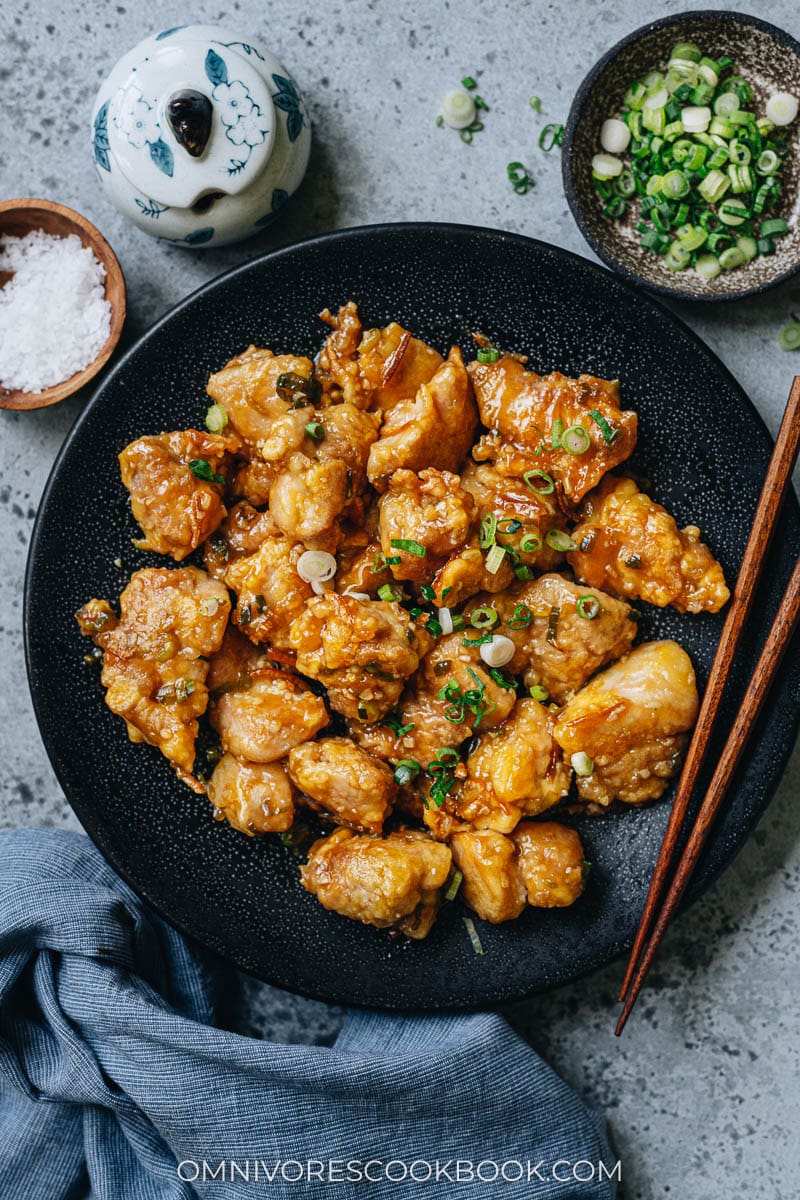
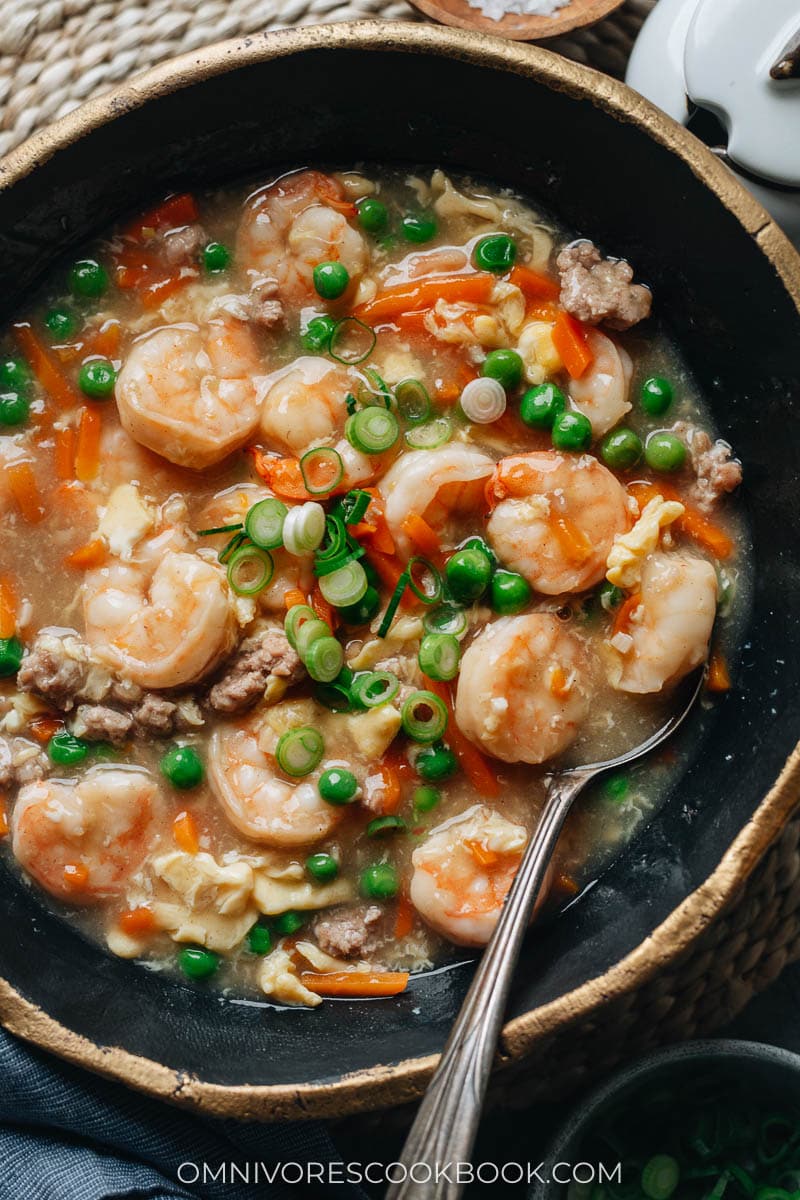
How to drink Shaoxing wine
While Shaoxing wine is an essential ingredient for authentic Chinese cooking, it can also be drunk, as it pairs especially well with Chinese food and is believed to have certain medicinal benefits.
The wine can be enjoyed chilled, at room temperature, or hot. Either chilling or heating the wine will make the flavor milder.
If heating Shaoxing wine, it’s important to heat it gently, to get it to the point of steaming but not boiling. Either use a heavy pot over low or medium-low heat, or use a water bath method like you might for hot sake.
The wine may be infused with dried fruits and herbs, both to add flavor and dimension and for medicinal purposes (see TCM section below).
How to shop for Shaoxing wine
There are two main versions of Shaoxing wine commonly available. One is called “cooking wine” and has salt added, so that it can be sold as a “non-alcoholic” product. One is simply Shaoxing wine and doesn’t contain salt.
I highly recommend the unsalted version because:
- It allows for more versatility – you may not always want the salt, whether cooking with it or drinking it.
- It will give you more consistent results when cooking – different types of salted Shaoxing wine may contain different amounts of salt, so you will need to tweak the salt in your recipe.
- My recipes assume the unsalted version – if you are using salted Shaoxing wine, you’ll need to reduce the salty ingredients in the recipe.
You can typically find the salted version (Shaoxing cooking wine) at Chinese grocery stores and it is available on The Mala Market.
Where to find the unsalted version
Regular, unsalted Shaoxing wine may be trickier to find, depending on where you are, but it’s totally worth it. If you are in a state that allows wine to be sold in supermarkets (e.g. California, Texas) you can probably find it at your local Chinese grocery store in the wine section. (Be sure to check the label to make sure there isn’t salt in it.)
However, in New York State, unsalted Shaoxing wine is not available at grocery stores. And I have to go to a liquor/wine shop to find it. I suspect this may be the case in some other states, too.
There are online wine stores that carry unsalted Shaoxing wine. But check to see whether they can deliver to your state (laws can vary). Astor Wines is a great shop that carries Shaoxing wine and will ship to most of the country.
If you are in NYC, you can visit Astor’s shop in Greenwich Village (link above), R&S 49 Liquor in Manhattan Chinatown, or 43 Liquors in Brooklyn Chinatown. Also, several NYC shops on Drizly carry unsalted Shaoxing wine.
How to store
Any type of Shaoxing wine should be stored in a cool, dry place. It will typically be good for at least 6 months once opened. Unopened, it should be good indefinitely.
I store my unsalted Shaoxing wine in the cupboard at room temperature and have never had issues with spoilage. Though if you don’t think you’ll finish the bottle within 6 months, you can preserve its flavor for up to a year if you refrigerate it.
Salted Shaoxing wine should be good for at least a year in the cupboard, since salt acts as a preservative.
Substitution
My preferred substitute for Shaoxing wine is dry sherry (NOT “cooking sherry”, which is salted). It has about 90% of the umami and fragrance of Shaoxing and it is pretty widely available wherever wine is sold. I admit that it is missing a little bit of the maltiness of Shaoxing wine. But if the rest of your ingredients are authentic, the difference will be hard to notice.
You can also use Japanese sake as a substitute, though it is less ideal if authentic flavor is your goal. Sake is milder in fragrance and doesn’t hold up quite as well to the relatively aggressive Chinese flavors. If the dish is a less intense one, and not spicy, sake could be a passable substitute.
I do NOT recommend mirin as a substitute for Shaoxing wine). It’s too sweet and can easily ruin the flavor profile of a recipe that calls for Shaoxing.
If you are avoiding alcohol completely, you can substitute an equal amount of chicken or vegetable broth to contribute a bit of savory essence.
Shaoxing wine in traditional Chinese medicine
Shaoxing wine is valued in traditional Chinese medicine (TCM) for its warming and qi-enhancing properties. As such, it is considered to have a range of health benefits when drunk in modest amounts in certain circumstances.
Shaoxing wine may be made into a medicinal wine (药酒 yàojiǔ) by adding dried fruits, herbs, and spices with particular TCM characteristics. The ingredients are added to the wine, and the wine is sealed and left alone for some weeks or months. The alcohol content of the wine acts to extract the beneficial components of the medicinal ingredients and make them more available.
The medicinal wine is always heated before consumption, along with the infused ingredients. Goji berries, jujubes, ginger, and walnuts are common, though many other ingredients can be used based on specific circumstances and a TCM practitioner’s guidance.
Not being trained in TCM myself, I can’t comment much on the topic. But I can say that a small cup of warm Shaoxing wine with nuts and berries can be a soothing accompaniment to a meal on a cold day.
Frequently asked questions
Is Shaoxing wine gluten-free?
No, it is not, since it contains wheat. For a gluten-free alternative, dry sherry does a great job.
Can I use Shaoxing wine in place of dry sherry?
Yes, you can. I have used it in Western-style recipes that called for sherry (pork stew, roasted mushrooms, cream sauce) and gotten great results. Shaoxing wine is not exactly the same, but will create a beautiful aroma and depth of flavor in all kinds of savory Western dishes.
Is Shaoxing wine the same as rice wine?
It is a specific type of rice wine, so yes. If a recipe simply calls for “rice wine”, you can use Shaoxing, sake, or other types of rice wine. Dry sherry should also be fine.
How is Shaoxing wine different from Japanese sake?
Both types of wine have rice in common. Though Shaoxing wine contains fermented wheat and is aged in clay urns, so it has a significantly earthier character. They are similar in terms of alcohol content. Though sake has many varieties, Shaoxing is a single type of rice wine with a few different varieties.
Are there different quality levels of Shaoxing wine? Does price matter?
There is a range of Shaoxing wine produced in China, from very cheap to very expensive. The ones that make it to the US are almost all in the mid range. The fancier ones are typically intended for drinking on special occasions, in any case. And the cheaper, more available ones are perfectly good for cooking. Depending where you are, a suitable wine should run between 5 and 8, not more than 10, dollars.
What brands do you recommend?
Pagoda seems to be the most widely available brand in the US. They sell both salted and unsalted, and Hua Tiao (drier) and Jia Fan (sweeter) varieties. I have used Pagoda wine extensively and highly recommend their unsalted varieties (see “How to shop” above). I have been using the Cheng brand “Huang Chiew Rice Wine” (Hua Tiao variety) lately and found it very good. It is technically not Shaoxing wine, but identical for our purposes here.
Recipes using Shaoxing wine
Shaoxing is practically everywhere in Chinese cooking, but these are some of my favorites, as they show you what the wine is capable of.
- Drunken Chicken is a cold appetizer that will show you the true beauty of Shaoxing wine, its fragrance enhanced by dried fruits and spices.
- Steamed Whole Fish uses the wine to eliminate the fishiness taste, and add a rich savory umami to the very lightly seasoned dish.
- Sweet & Sour Pork uses Shaoxing to balance the richness of the pork and elevate the aroma of the dish.
- Hong Shao Rou is a classic dish with a Shaoxing-based braising sauce that infuses a world of umami and tenderness into luscious pork belly.
- Black Pepper Chicken uses Shaoxing wine in both the marinade and the sauce to create a huge savory base to support the black pepper.
- Authentic Mapo Tofu marinates the ground meat in Shaoxing wine to give it some dimension so it can stand up to the dazzling spicy sauce.
- Sichuan Yu Xiang Eggplant has Shaoxing wine in the sauce, to boost the umami and enhance the spice.
- Lion’s Head Meatballs uses a generous amount of Shaoxing to make the pork irresistibly savory and fragrant.
Pork Dumplings, Chicken Dumplings, Beef Dumplings, Soup Dumplings, Lamb Dumplings, and Wontons all use Shaoxing wine in the filling.
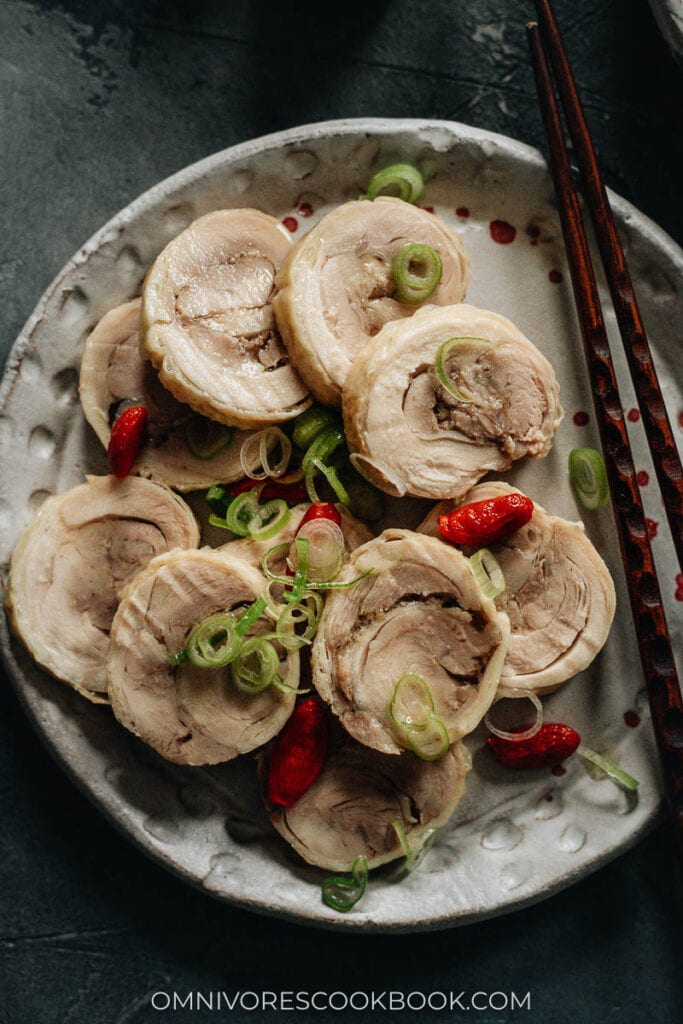
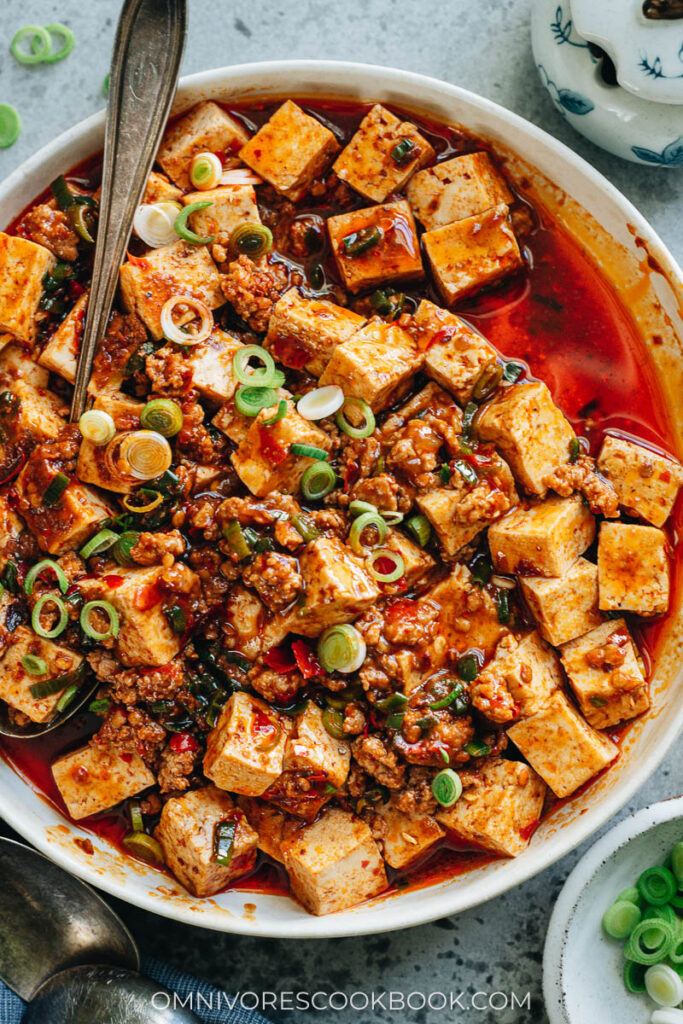

Shauna
What if I don’t have either
DUANE MITCH
I cant wait to try this recipe. What is a good choice for SAKE, with the American tongue?
Maggie Zhu
There are many sake brands that produce affordable sake that is nice for drinking and perfect for cooking.
Some big brands that you can easily find is Gekkeikan, Hakutsuru, Kikusui, and Sho Chiku Bai.
For cooking, most of the sake will work. Or you can pick a bottle that is slightly more expensive that the cheapest one available.
For drinking, the sake labeled “jun mai” (crisp) or “jun mai gin jo”, or “jun mai daiginjo” (most refined taste) have higher grade.
The unfiltered sake (nigori) is slightly sweeter and fun to drink, but not suitable for cooking.
Lynn
This was so helpful.
Barbara
Thanks for this. I purchased a bottle of Shaoxing wine from a local Chinese restaurant in Nikko, Japan. I was surprised and delighted at the flavor it gave to the dishes I was making. I first tried a sip of it — and it was terrible! So it may be an acquired taste for a cocktail, but the aroma it and flavor it gave to the Chinese dishes I prepared was undeniable! Now, I’m a believer. Buy the best Shaoxing wine you can find. Ask about the salt. Use Google translate as a backup — but get this wine and make it a “must-have” ingredient for your Chinese dishes. I made Zhu’s Cashew Chicken and it’s an essential ingredient. The Cashew Chicken was incredibly delicious and gave me great pleasure to have made such a crowd-pleasing dish.
Diane
new to this. We went Vegan and my husband misses Sichuan beef. I think I can work around real beef with vegan substitute. I have subscribed.I am looking forward to the new information.
Kerrie
This was really helpful. Thank you so much!!